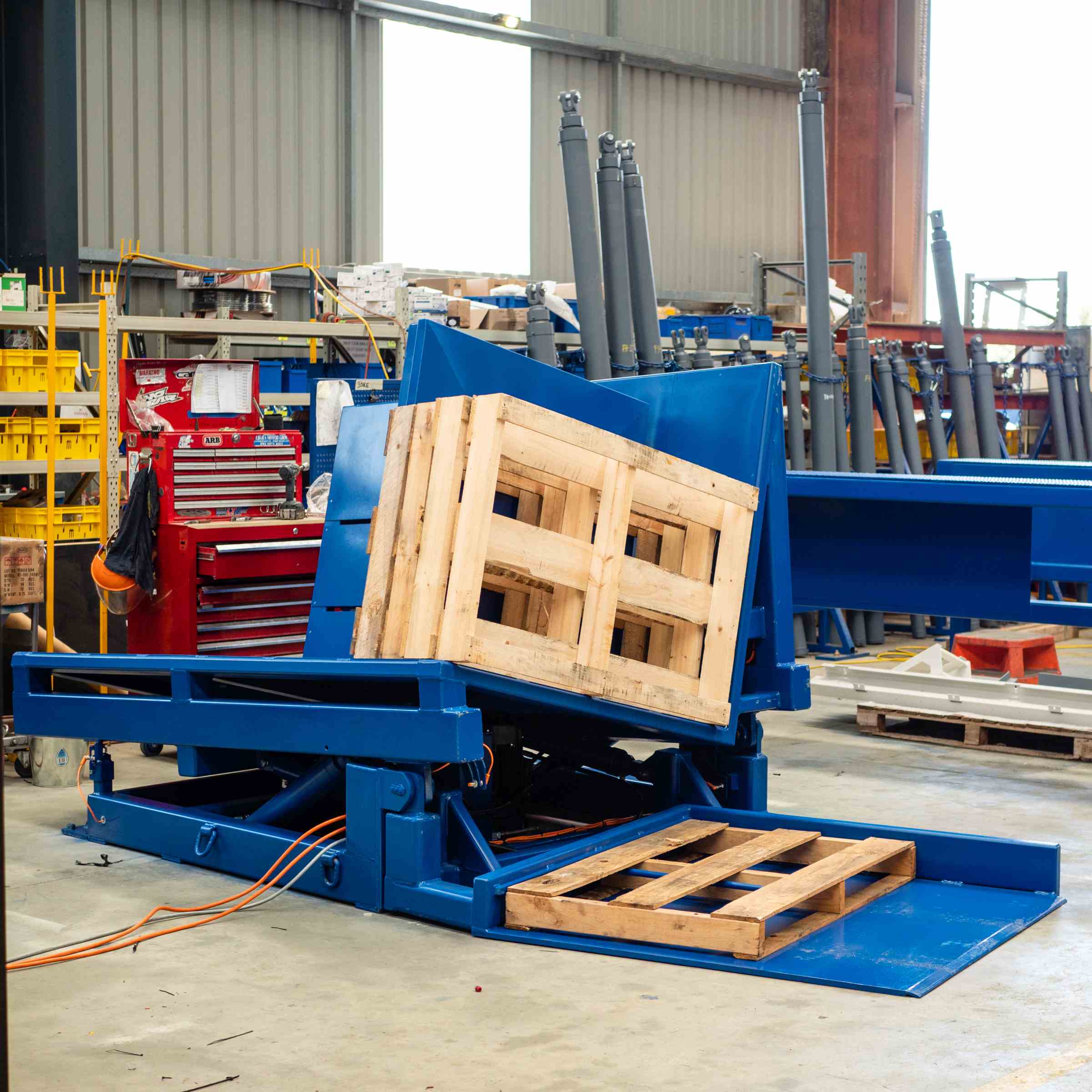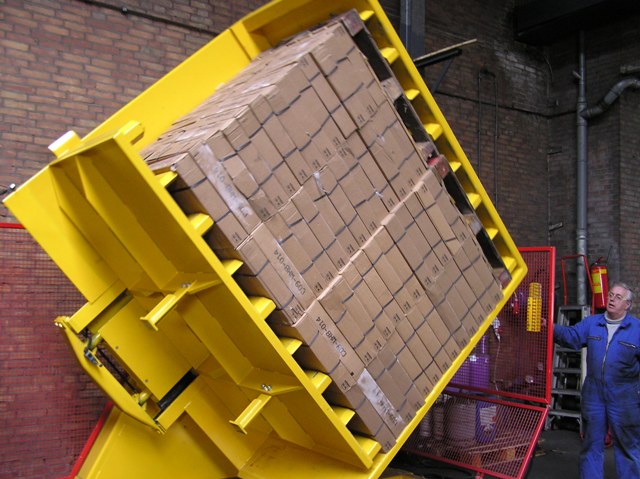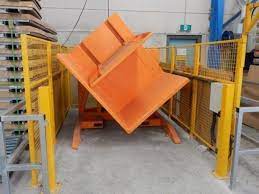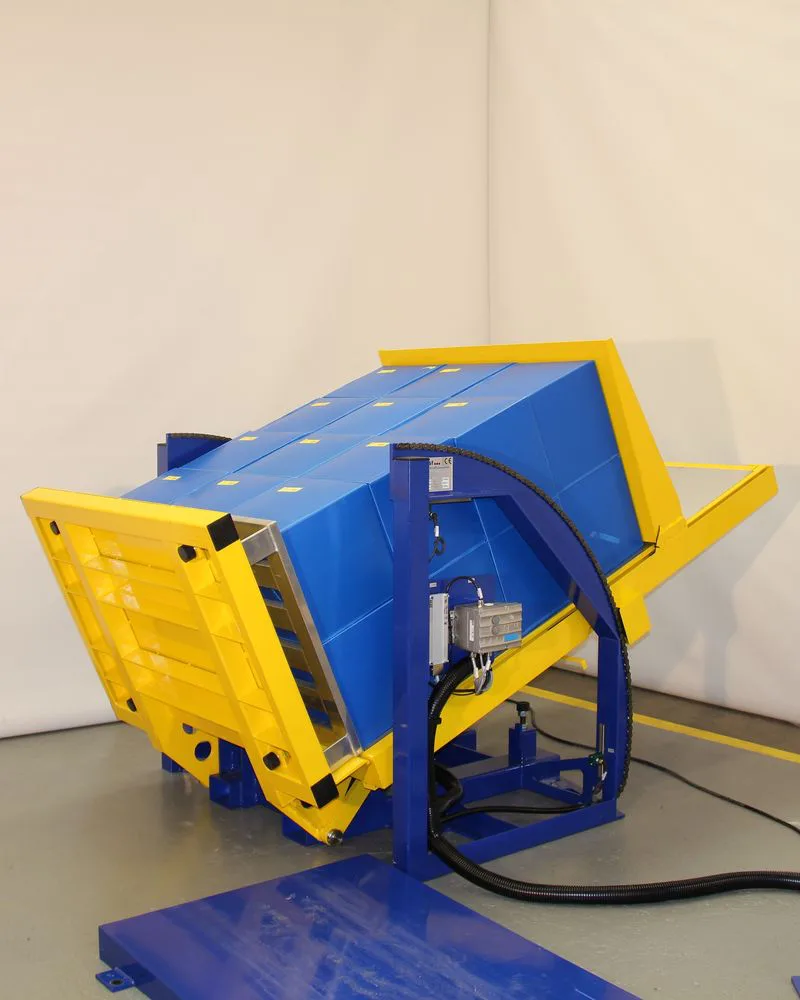Achieving Precise & Safe Mold Opening: A Deep Dive into Mold Flipper's Technical Advantages
Handling large, heavy molds is one of the most critical and dangerous tasks in any industrial setting. I remember my early days as an engineer on the factory floor, watching teams use cranes and chains to flip massive steel molds. Every single time, I held my breath. A slight miscalculation, a single weak link in a chain, and you're looking at a damaged multi-thousand-dollar mold, or far worse, a life-changing injury for an operator. This isn't just a hypothetical problem; it's a constant source of anxiety and risk that keeps plant owners and managers up at night. The hidden costs of these outdated methods, from production downtime to potential accidents, can slowly erode your bottom line and create a culture of fear instead of efficiency.
A mold flipper achieves precise and safe mold opening by using a powerful, controlled system to rotate heavy objects within a secure mechanical structure. Its core technical advantages lie in a combination of robust engineering, such as heavy-duty frames and reliable drive systems (either hydraulic or electromechanical), and intelligent design, including integrated safety interlocks and precise positioning controls. This allows the machine to smoothly turn molds 90 or 180 degrees without the shock, vibration, or risk of slipping associated with traditional crane and chain methods, directly protecting both the valuable mold and the personnel operating the equipment.

This isn't just about avoiding disaster. It's about creating a fundamentally better, more profitable process. When you remove that risk and unpredictability, you unlock new levels of efficiency and quality. In my journey from engineer to factory owner, I've seen firsthand that the smartest investments are the ones that tackle core safety and process challenges head-on. Let’s take a closer look at the specific technical advantages that make a mold flipper an essential tool, not just a luxury. We will explore how it enhances safety, what makes it so precise, how it integrates into your current workflow, and what the real return on this investment looks like.
How Can a Mold Flipper Enhance Operator Safety During Mold Handling?
In any heavy industry, especially a steel mill, the safety of your people is the highest priority. I've walked through countless factories and seen the inherent dangers of turning heavy molds with cranes. The process is often slow, requires multiple operators in close proximity to a suspended load, and relies entirely on the skill of the crane operator and the integrity of slings and chains. A sudden shift in the center of gravity can cause the mold to swing uncontrollably. This is a scenario that carries an unacceptable level of risk. The question is no longer if an accident will happen, but when.
A dedicated mold flipper is engineered specifically to eliminate these risks by creating a controlled, predictable, and secure environment for mold handling. The entire process is designed to keep operators out of the danger zone. Instead of manually rigging chains and guiding a suspended load, an operator can manage the entire flipping process from a safe distance using a simple control panel or remote. This single change transforms a high-risk manual task into a supervised, automated procedure, drastically reducing the potential for human error and injury.

Dive Deeper into Safety Mechanisms
To truly understand the safety impact, we need to look at the specific engineering choices that make a mold flipper a fortress of safety. It’s not one single feature, but a combination of interlocking systems that work together. I've always believed that great engineering is about anticipating problems and designing them out of the system.
Secure Clamping and Support
The foundation of the machine's safety is its ability to hold the mold with absolute certainty.
- Massive Support Tables: The mold rests on two heavy-duty steel tables or platforms. These are not simple plates; they are engineered structures designed to bear loads far exceeding the machine's rated capacity without any deflection.
- Powerful Clamping System: Once the mold is loaded, a hydraulic or electromechanical clamping system engages. This system applies consistent, distributed pressure to hold the mold firmly in place. Unlike chains that concentrate force on small points, these clamps secure a large surface area, preventing any chance of slippage during the rotation. The clamping pressure is also adjustable to suit different mold sizes and weights, but always operates within safe parameters.
Controlled and Stable Rotation
The most dangerous part of the manual process is the uncontrolled movement. A mold flipper replaces that chaos with perfect control.
- Smooth Drive System: The rotation is powered by either a robust hydraulic motor or a high-torque electromechanical gear motor. These systems are designed for smooth, gradual acceleration and deceleration. There are no sudden jerks or shocks that could destabilize the load.
- Low Center of Gravity: The entire machine is built to be bottom-heavy. This inherent stability ensures that even when rotating the heaviest molds at its capacity, the machine itself remains perfectly stable and planted on the floor.
Failsafe and Interlock Systems
A truly safe machine protects against not just normal operation, but also potential failures or misuse.
- Limit Switches: These physical switches prevent the machine from over-rotating, ensuring it stops precisely at 90 or 180 degrees.
- Pressure Relief Valves: In hydraulic models, these valves prevent the system from becoming over-pressurized, acting as a critical failsafe.
- Emergency Stops: Prominently placed E-stop buttons can halt all machine movement instantly.
- Safety Interlocks: The machine can be designed so it will not operate unless all safety guards are in place and the mold is properly detected by sensors.
| Safety Aspect | Traditional Method (Crane & Chains) | Mold Flipper Method |
|---|---|---|
| Operator Proximity | High (Operators must be near the load) | Low (Operators control from a safe distance) |
| Load Security | Low (Relies on chain/sling integrity) | High (Securely clamped to a stable platform) |
| Movement Control | Low (Prone to swinging and jerking) | High (Smooth, predictable, and controlled rotation) |
| Failure Risk | High (Chain failure, human error) | Low (Engineered with multiple failsafe systems) |
This focus on engineered safety doesn't just prevent accidents. It builds operator confidence, which in turn leads to a more focused and efficient workforce.
What Are the Core Mechanisms Driving the Precision of a Mold Flipper?
When you handle a mold worth tens or even hundreds of thousands of dollars, precision is not a luxury—it's a necessity. A small scratch, dent, or misalignment caused by improper handling can lead to flawed parts, costly repairs, and significant production delays. I’ve seen situations where a mold was damaged during a manual flip, and the resulting downtime and repair costs were greater than the price of a new mold flipper. This is the hidden tax of imprecision. Business owners often focus on output, but maintaining the integrity of your core assets, like molds, is fundamental to long-term profitability.
The core mechanisms driving the precision of a mold flipper are its rigid structural design and its highly controllable drive system. The machine's frame is over-engineered to resist any twisting or flexing under load, ensuring the mold is held in a perfect plane throughout the rotation. This structural integrity is paired with either a smooth hydraulic system or a variable frequency drive (VFD) controlled electric motor. These drive systems allow for extremely precise control over the speed and angle of rotation, enabling the machine to place the mold down gently and accurately, every single time.

Dive Deeper into Precision Engineering
Let's break down the engineering that separates a mold flipper from a simple turning device. Precision comes from a holistic design philosophy where every component works in concert.
Structural Rigidity: The Unyielding Foundation
The first principle of precision is a stable reference frame.
- Heavy-Gauge Steel Construction: The entire body of the mold flipper is constructed from thick, high-strength steel plates and structural beams. These are welded together by certified welders and often stress-relieved to ensure long-term dimensional stability. This massive frame acts as a solid bedrock, absorbing all rotational forces without deforming. When the machine doesn't flex, the mold it's holding doesn't either.
- Finite Element Analysis (FEA): During the design phase, we use advanced computer simulations (FEA) to model the stresses on the machine's frame under maximum load. This allows us to identify and reinforce any potential weak points long before any steel is cut. It’s how we guarantee the structure is more than capable of handling the forces involved with zero deflection.
Drive System Control: The Art of Movement
A rigid structure needs a sophisticated muscle to move it. The choice of drive system is critical for precision.
- Hydraulic Systems: For extremely heavy loads, hydraulic systems are often preferred. They offer immense power and incredibly smooth control. Proportional valves allow the operator to feather the movement, starting and stopping the rotation with exceptional gentleness. This prevents any shock from being transmitted to the delicate surfaces of the mold.
- Electromechanical Systems with VFDs: For many applications, an electric motor paired with a heavy-duty gearbox and a Variable Frequency Drive (VFD) is the ideal solution. The VFD allows for precise control over the motor's speed. We can program "S-curves" for acceleration and deceleration, meaning the rotation starts slowly, ramps up to a safe speed, and then gently slows down before stopping. This eliminates any jarring movements and allows for precise positioning to a fraction of a degree.
| Feature | Impact on Precision |
|---|---|
| Overbuilt Steel Frame | Prevents flexing, keeping the mold perfectly aligned. |
| FEA-Optimized Design | Ensures structural integrity under all load conditions. |
| Hydraulic Proportional Valves | Delivers smooth, shock-free power for gentle handling. |
| VFD-Controlled Motor | Enables programmable speed control for soft starts/stops and exact positioning. |
| Precision Bearings | Ensures a smooth, low-friction rotational axis with no "slop" or play. |
When we deliver a machine, we're not just delivering a piece of equipment. We're delivering a guarantee of precision. This precision protects your molds, improves the quality of your finished products, and eliminates the unpredictable delays that come from handling damage. It turns a variable, high-risk process into a repeatable, high-quality one.
How Does a Mold Flipper Integrate with Existing Production Lines to Boost Efficiency?
Bringing a new piece of major equipment into an established factory can be a major disruption. For a steel mill owner like Javier, who is managing aging production lines and focused on maximizing uptime, the last thing he needs is a machine that creates a new bottleneck. A new machine must feel like it was always there, seamlessly fitting into the existing flow of materials and work. If it requires a complete overhaul of your processes, its benefits can be quickly outweighed by the cost and chaos of implementation.
A well-designed mold flipper integrates with existing production lines by acting as a centralized, efficient hub for mold handling, rather than a disruptive addon. It is designed to be compatible with standard material handling equipment like overhead cranes and forklifts. By strategically placing the flipper in the workflow—for example, between the mold storage area and the press line, or within the maintenance bay—it dramatically reduces the time and labor required for mold opening, closing, and inspection. This turns a complex, multi-step process into a simple, single-station task, directly boosting overall operational efficiency.

Dive Deeper into Integration and Workflow
Boosting efficiency isn't just about the machine's cycle time; it's about how it enhances the entire ecosystem of your production floor. I believe a machine's true value is measured by how much it simplifies everything around it.
Strategic Placement and Workflow Analysis
The first step to seamless integration is understanding the client's unique workflow. There is no one-size-fits-all solution.
- In the Maintenance Bay: Placing the flipper in the tool and die maintenance area is a common and highly effective strategy. When a mold comes off the line for service, it goes directly to the flipper. The maintenance team can safely open it, work on either half, and close it back up for testing without ever needing a crane for turning. This frees up the main production cranes for their primary job: moving molds to and from the presses.
- In-Line with Production: For operations with very frequent mold changes, the flipper can be installed directly in the production line. A crane or forklift places the old mold in the flipper, and while it's being handled, the next mold is being prepped. This "pit stop" model drastically cuts down on changeover time.
Compatibility with Existing Equipment
A mold flipper is designed to be a team player.
- Loading and Unloading: The open design allows for easy access by overhead cranes. The mold can be lowered directly onto the machine's table. Alternatively, cutouts in the base allow a forklift to drive in and place the mold. This flexibility means you don't need to invest in new, specialized handling equipment.
- Control System Integration: This is key for facilities pursuing digital transformation. The flipper's control system can be basic, with a simple push-button panel. But it can also be equipped with an interface to communicate with your factory's Manufacturing Execution System (MES). The MES can signal the flipper that a specific mold is ready for opening, track the time spent in maintenance, and confirm when the mold is ready to return to production. This provides the full production visibility that modern plant managers need.
Quantifying the Efficiency Gains
Let's look at a typical mold changeover scenario to see the real-world impact.
| Task | Traditional Crane Method | With Integrated Mold Flipper |
|---|---|---|
| Preparation | Wait for crane, find proper chains, rig the mold. (15-20 min) | Crane/forklift moves mold to flipper. (5 min) |
| Turning | Slow, careful crane lift and turn with spotters. (10-15 min) | Secure clamps, press button for 90-second rotation. (3-5 min) |
| Post-Turn | Lower mold, unrig chains, clear the area. (10 min) | Unclamp, crane/forklift removes mold. (5 min) |
| Total Time | 35-45 minutes | 13-15 minutes |
| Labor | 2-3 operators (crane operator + spotters) | 1 operator |
This simple change can save 20-30 minutes per mold change. If you change molds multiple times a day, this time saving translates directly into more production hours and higher capacity utilization—a primary goal for any plant owner.
What is the Real ROI of a Mold Flipper Considering Maintenance and Longevity?
As a business owner, every major purchase comes down to one question: what is the return on investment (ROI)? It's easy to look at the initial price of a machine like a mold flipper and see it only as a cost. But a forward-thinking leader, especially one with an engineering background, knows that the sticker price is only one part of the equation. You have to consider the total cost of not investing—the ongoing costs of inefficiency, the financial risk of accidents, and the high price of production downtime.
The real ROI of a mold flipper is realized by calculating its impact on total operational cost and risk reduction over its entire lifespan. It's a multifaceted return that includes tangible savings from reduced labor and eliminated mold damage, and intangible but highly valuable gains from improved safety and increased production uptime. Because these machines are built for extreme longevity with minimal maintenance, the initial investment is paid back many times over by preventing just one serious accident or saving one expensive mold from damage.

Dive Deeper into Calculating Total Value
I built my own business by focusing on value, not just price. Let's break down the components of the ROI calculation so you can see the full picture.
Tangible Financial Returns (The Easy Math)
These are the numbers you can plug directly into a spreadsheet.
- Reduced Labor Costs: As shown before, a task that once required two or three skilled workers can now be done by one. Calculate the hourly wage of those employees multiplied by the time saved per flip, multiplied by the number of flips per year. This alone can add up to thousands of dollars.
- Elimination of Mold Damage Costs: This is a huge factor. Ask yourself: how much did we spend on mold repair due to handling incidents in the last five years? How much production was lost during those repairs? A mold flipper virtually eliminates this entire category of expense. Preventing just one incident can often pay for the machine outright.
- Increased Production Uptime: Faster mold changeovers mean more time making products. If your plant is running at or near capacity, every minute of extra production time is pure profit. Calculate the value of your output per hour and multiply it by the hours saved in changeovers per year.
Intangible, High-Value Returns (The Hard-to-Measure, Easy-to-Appreciate)
These benefits don't always have a clear dollar value, but they are critical to a healthy business.
- Drastically Improved Safety: What is the cost of a serious injury? It's immense. There are direct costs like medical bills and insurance premium hikes, and indirect costs like lost morale, government investigations, and damage to your company's reputation. A mold flipper is one of the best insurance policies you can buy against these events.
- Operator Morale and Retention: When you invest in tools that make your employees' jobs safer and easier, they notice. It shows you value them. This leads to higher morale, better employee retention, and a more positive and productive work environment.
- Predictability and Stability: By removing the unpredictability of manual handling, you create a more stable and predictable production environment. This makes scheduling easier, reduces stress on managers, and helps you meet customer deadlines more reliably.
Longevity and Low Maintenance: The Long-Term View
This investment isn't for one or two years; it's for decades.
- Built to Last: These machines are not complex. They are made of heavy steel and use proven, robust components like industrial-grade motors, gearboxes, and hydraulic cylinders. I've seen flippers that I helped install 15 years ago still operating flawlessly today. They are designed to withstand the harsh environment of a steel mill.
- Simple Maintenance: The maintenance needs are minimal and straightforward: regular greasing of bearings, checking hydraulic fluid levels, and inspecting electrical connections. There are no complex software updates or delicate electronics to worry about. This low cost of ownership is a key part of the ROI.
When you add up the tangible savings, the risk reduction, and the decades of reliable service, the ROI for a mold flipper becomes overwhelmingly positive. It's not an expense; it's a strategic investment in a safer, more efficient, and more profitable future.
Conclusion
Ultimately, a mold flipper is a fundamental investment in control. It provides control over safety, precision, and efficiency, transforming a high-risk manual task into a reliable, automated process.

